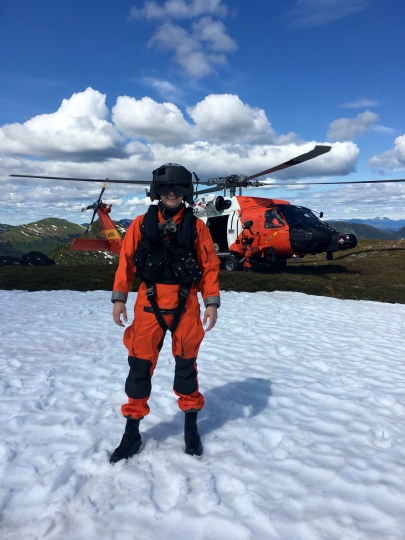Andrew Lund, S.M. ‘18
Lieutenant Commander Andrew Lund never knows when he’ll need to save a life. In his nearly 20 years of service with the United States Coast Guard (USCG), Lund, ‘S.M. ‘18, has flown search-and-rescue missions into some of the worst weather imaginable.
“When I’m on duty we’ll launch into whatever weather, storm, or tough case there may be in order to try and bring people home to their families,” Lund said. “I flew one of the first helicopters into Hurricane Sandy in New York City in 2012. I flew into blizzard conditions up in Alaska. I’ve flown out over the ocean with 30-foot seas. We are a finely trained service that I’m glad we’re able to offer to our citizens.”
To prepare for his eventual transition out of the cockpit and into an analyst position at the USCG headquarters in Washington, D.C., Lund enrolled in the Institute for Applied Computational Science (IACS) at the Harvard John A. Paulson School of Engineering (SEAS).
“I wanted to do something technical with the brain that I was born with, so I focused really heavily on the operations research track that we have as a sub-specialty,” he said. “I’m on track to do some sort of executive leadership in the Coast Guard, where you’re leading a very diverse group of folks.”
Growing up in Washington state, Lund knew by the seventh grade that he wanted to be a military pilot. He considered the Air Force Academy, but ultimately was drawn to the USCG's humanitarian mission.
He studied civil engineering as an undergraduate at the Coast Guard Academy in New London, Conn, and upon graduation was sent to Florida for naval flight training. His air station assignments have included Cape Cod, Sitka, Alaska, and currently Astoria, Oregon.
“We’re primarily here to save lives,” Lund said. “It’s a challenging mission that’s different from the Department of Defense, which generally trains for deployments for specific operations. We train for the 365-day mission.”
Andrew Lund's career in the United States Coast Guard included flying helicopters out of Air Station Sitka in Alaska.
When Lund began to think about broadening his knowledge beyond the hands-on training of flying a search-and-rescue helicopter, he turned to Academy classmate Isaac Slavitt, who’d also studied computational science and engineering at Harvard and is now an IACS Fellow.
“Having majored in civil engineering at the Academy, Andy was going in with less coding experience, so it was bound to be extra challenging for him to get prepared,” Slavitt said. “But Andy is one of the most driven and capable people I've ever met, and I had no doubt he was up to the task. When Andy was considering graduate programs, I told him he had to apply.”
Lund’s capstone project for his master’s program at SEAS involved updating the ways the Associated Press assigns metadata tags to its stories. That experience proved invaluable to Lund in DC, where he worked to improve the Coast Guard’s human resources practices.
“This is notorious across the government: we build something for a particular project, and then it just stagnates and rarely gets updated,” he said. While at Headquarters, “My team and I applied modern data science techniques to the Coast Guard’s human resources data and were able to inform a number of high-level briefings with good data-based metrics and trends behind them. The Coast Guard has about 32,000 enlisted members, and we need to forecast them from accession, when they come off the street in jeans and a t-shirt, through boot camp, and then all the way out until 30 years of service, when we politely ask them to retire. We’re trying to recruit the right types of people at the right time to be in the right jobs, and then we have to smartly allocate tax dollars to pay them.”
Along with a new approach to human resources analysis, Lund also successfully lobbied for specific software changes.
“The most important skills that I learned in the IACS program were how to code in Python and how to create smart data visualizations,” he said. “Nobody in the Coast Guard was using Python when I arrived at Headquarters, and it wasn’t an authorized program on our workstations. We can now get Python put on any of the tens of thousands of computers in the Coast Guard. We also pushed for a sub-specialty called ‘Operations Research and Data Analytics,’ which specifically focuses on Python and the modern data science skills that I learned at Harvard.”
Lund is currently the Assistant Air Operations Officer and a Flight Examiner at Air Station Astoria, but knows he won’t stay in the air forever. His IACS education is exactly the kind of data science training he’ll need to advance to greater leadership positions, and he anticipates he and his wife and two children will at some point return to DC.
Thanks to SEAS and the IACS, when that happens, Lund will be ready.
“I am incredibly grateful that I went through this program,” Lund said. “It was both a very high-level technical experience, and I also got a very broad experience. I got to learn from some of the smartest folks I think I’ll ever be surrounded by for the rest of my life, and I couldn’t pass up the opportunity to work and live in Cambridge for a year.”
Press Contact
Matt Goisman | mgoisman@g.harvard.edu

